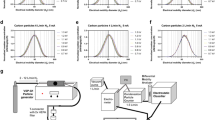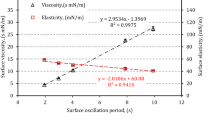Abstract
Despite the great use of nanomaterials for engineering and medical applications, nanomaterials may have adverse consequences by accidental exposure, because of their nanoscale size, composition and shape. Like many nanomaterials, carbon nanotubes (CNTs) have been used for many proven applications, but the size of the CNTs makes them more readily become airborne and can therefore create the risk of being inhaled by a worker. In this study, we evaluated single-walled CNT (SWCNT)-induced effects on cellular responses such as cell proliferation, inflammatory response and oxidative stress in dynamic cell growth condition. A dynamic cell growth environment was established to mimic the dynamic changes in the amount of circumferential and longitudinal expansion and contraction occurred during normal breathing movement in the lung. Two different length (short: outer diameter (OD) 1–2 nm, length 0.5–2 μm; long: OD 1–2 nm, length 5–30 μm) of SWCNTs were used at different exposure concentrations (5, 10 and 20 μg/ml) during the different exposure duration (24, 48 and 72 h). Dynamic environment facilitated altered interaction between SWCNTs and A549 monolayer. Cellular responses in dynamic condition were significantly different from those in static condition. Moreover, cellular responses were dependent on the length of SWCNTs both in static and dynamic cell growth conditions.
This is a preview of subscription content, access via your institution
Access options
Subscribe to this journal
Receive 6 print issues and online access
$259.00 per year
only $43.17 per issue
Buy this article
- Purchase on Springer Link
- Instant access to full article PDF
Prices may be subject to local taxes which are calculated during checkout







Similar content being viewed by others
References
Baron P.A., Maynard A.D., and Foley M. Evaluation of aerosol release during the handling of unrefined single walled carbon nanotube materials. Carbon Nanotube Aerosol Generation 2003: NIOSH DART-02-191 Rev. 1.1: 1–22.
Chou C.C., Hsiao H.Y., Hong Q.S., Chen C.H., Peng Y.W., Chen H.W. et al. Single-walled carbon nanotubes can induce pulmonary injury in mouse model. Nano Lett 2008: 8 (2): 437–445.
Lam C.W., James J.T., McCluskey R., and Hunter R.L. Pulmonary toxicity of single-wall carbon nanotubes in mice 7 and 90 days after intratracheal instillation. Toxicol Sci 2004: 77 (1): 126–134.
Li Z., Hulderman T., Salmen R., Chapman R., Leonard S.S., Young S.H. et al. Cardiovascular effects of pulmonary exposure to single-wall carbon nanotubes. Environ Health Perspect 2007: 115 (3): 377–382.
Mitchell L.A., Gao J., Wal R.V., Gigliotti A., Burchiel S.W., and McDonald J.D. Pulmonary and systemic immune response to inhaled multiwalled carbon nanotubes. Toxicol Sci 2007: 100 (1): 203–214.
Muller J., Huaux F., Moreau N., Misson P., Heilier J.F., Delos M. et al. Respiratory toxicity of multi-wall carbon nanotubes. Toxicol Appl Pharmacol 2005: 207 (3): 221–231.
Shvedova A.A., Kisin E.R., Mercer R., Murray A.R., Johnson V.J., Potapovich A.I. et al. Unusual inflammatory and fibrogenic pulmonary responses to single-walled carbon nanotubes in mice. Am J Physiol Lung Cell Mol Physiol 2005: 289 (5): L698–L708.
Warheit D.B., Laurence B.R., Reed K.L., Roach D.H., Reynolds G.A., and Webb T.R. Comparative pulmonary toxicity assessment of single-wall carbon nanotubes in rats. Toxicol Sci 2004: 77 (1): 117–125.
Helland A., Wick P., Koehler A., Schmid K., and Som C. Reviewing the environmental and human health knowledge base of carbon nanotubes. Environ Health Perspect 2007: 115 (8): 1125–1131.
Donaldson K., Aitken R., Tran L., Stone V., Duffin R., Forrest G. et al. Carbon nanotubes: a review of their properties in relation to pulmonary toxicology and workplace safety. Toxicol Sci 2006: 92 (1): 5–22.
Chin S.F., Baughman R.H., Dalton A.B., Dieckmann G.R., Draper R.K., Mikoryak C. et al. Amphiphilic helical peptide enhances the uptake of single-walled carbon nanotubes by living cells. Exp Biol Med (Maywood) 2007: 232 (9): 1236–1244.
Dumortier H., Lacotte S., Pastorin G., Marega R., Wu W., Bonifazi D. et al. Functionalized carbon nanotubes are non-cytotoxic and preserve the functionality of primary immune cells. Nano Lett 2006: 6 (7): 1522–1528.
Lam C.W., James J.T., McCluskey R., Arepalli S., and Hunter R.L. A review of carbon nanotube toxicity and assessment of potential occupational and environmental health risks. Crit Rev Toxicol 2006: 36 (3): 189–217.
Yang K., Wang X., Zhu L., and Xing B. Competitive sorption of pyrene, phenanthrene, and naphthalene on multiwalled carbon nanotubes. Environ Sci Technol 2006: 40 (18): 5804–5810.
Rothen-Rutishauser B., Muhlfeld C., Blank F., Musso C., and Gehr P. Translocation of particles and inflammatory responses after exposure to fine particles and nanoparticles in an epithelial airway model. Part Fibre Toxicol 2007: 4: 9.
Shimada A., Kawamura N., Okajima M., Kaewamatawong T., Inoue H., and Morita T. Translocation pathway of the intratracheally instilled ultrafine particles from the lung into the blood circulation in the mouse. Toxicol Pathol 2006: 34 (7): 949–957.
Kim H.R., Andrieux K., Gil S., Taverna M., Chacun H., Desmaele D. et al. Translocation of poly(ethylene glycol-co-hexadecyl)cyanoacrylate nanoparticles into rat brain endothelial cells: role of apolipoproteins in receptor-mediated endocytosis. Biomacromolecules 2007: 8 (3): 793–799.
Sohaebuddin S.K., Thevenot P.T., Baker D., Eaton J.W., and Tang L. Nanomaterial cytotoxicity is composition, size, and cell type dependent. Part Fibre Toxicol 2010: 7: 22.
Yamashita K., Yoshioka Y., Higashisaka K., Morishita Y., Yoshida T., Fujimura M. et al. Carbon nanotubes elicit DNA damage and inflammatory response relative to their size and shape. Inflammation 2010: 33 (4): 276–280.
Grainger D.W. Nanotoxicity assessment: all small talk?, 2009: 61 (6): 419–421.
Baktur R., Patel H., and Kwon S. Effect of exposure conditions on SWCNT-induced inflammatory response in human alveolar epithelial cells. Toxicol In Vitro Int J Publ Assoc BIBRA 2011: 25 (5): 1153–1160.
Patel H., Eo S., and Kwon S. Effects of diesel particulate matters on inflammatory responses in static and dynamic culture of human alveolar epithelial cells. Toxicol Lett 2011: 200 (1-2): 124–131.
Tschumperlin D.J., and Margulies S.S. Equibiaxial deformation-induced injury of alveolar epithelial cells in vitro. Am J Physiol 1998: 275 (6 Pt 1): L1173–L1183.
Cathcart R., Schwiers E., and Ames B.N. Detection of picomole levels of hydroperoxides using a fluorescent dichlorofluorescein assay. Anal Biochem 1983: 134 (1): 111–116.
Donaldson K., Murphy F., Schinwald A., Duffin R., and Poland C.A. Identifying the pulmonary hazard of high aspect ratio nanoparticles to enable their safety-by-design. Nanomedicine (Lond) 2011: 6 (1): 143–156.
Herzog E., Byrne H.J., Casey A., Davoren M., Lenz A.G., Maier K.L. et al. SWCNT suppress inflammatory mediator responses in human lung epithelium in vitro. Toxicol Appl Pharmacol 2009: 234 (3): 378–390.
Jacobsen N.R., Pojana G., White P., Moller P., Cohn C.A., Korsholm K.S. et al. Genotoxicity, cytotoxicity, and reactive oxygen species induced by single-walled carbon nanotubes and C(60) fullerenes in the FE1-Mutatrade markMouse lung epithelial cells. Environ Mol Mutagen 2008: 49 (6): 476–487.
Casey A., Herzog E., Lyng F.M., Byrne H.J., Chambers G., and Davoren M. Single walled carbon nanotubes induce indirect cytotoxicity by medium depletion in A549 lung cells. Toxicol Lett 2008: 179 (2): 78–84.
Liu X., Guo L., Morris D., Kane A.B., and Hurt R.H. Targeted removal of bioavailable metal as a detoxification strategy for carbon nanotubes. Carbon N Y 2008: 46 (3): 489–500.
Pulskamp K., Diabate S., and Krug H.F. Carbon nanotubes show no sign of acute toxicity but induce intracellular reactive oxygen species in dependence on contaminants. Toxicol Lett 2007: 168 (1): 58–74.
Ren L., Kim H.K., and Zhong W. Capillary electrophoresis-assisted identification of peroxyl radical generated by single-walled carbon nanotubes in a cell-free system. Anal Chem 2009: 81 (13): 5510–5516.
Ren L., and Zhong W. Oxidation reactions mediated by single-walled carbon nanotubes in aqueous solution. Environ Sci Technol 2010: 44 (18): 6954–6958.
Teeguarden J.G., Webb-Robertson B.J., Waters K.M., Murray A.R., Kisin E.R., Varnum S.M. et al. Comparative proteomics and pulmonary toxicity of instilled single-walled carbon nanotubes, crocidolite asbestos, and ultrafine carbon black in mice. Toxicol Sci 2011: 120 (1): 123–135.
Jacobsen N.R., Moller P., Jensen K.A., Vogel U., Ladefoged O., Loft S. et al. Lung inflammation and genotoxicity following pulmonary exposure to nanoparticles in ApoE-/- mice. Part Fibre Toxicol 2009: 6: 2.
Shvedova A.A., Kisin E.R., Murray A.R., Gorelik O., Arepalli S., Castranova V. et al. Vitamin E deficiency enhances pulmonary inflammatory response and oxidative stress induced by single-walled carbon nanotubes in C57BL/6 mice. Toxicol Appl Pharmacol 2007: 221 (3): 339–348.
Shvedova A.A., Kapralov A.A., Feng W.H., Kisin E.R., Murray A.R., Mercer R.R. et al. Impaired clearance and enhanced pulmonary inflammatory/fibrotic response to carbon nanotubes in myeloperoxidase-deficient mice. PloS One 2012: 7 (3): e30923.
Davoren M., Herzog E., Casey A., Cottineau B., Chambers G., Byrne H.J. et al. In vitro toxicity evaluation of single walled carbon nanotubes on human A549 lung cells. Toxicol In Vitro Int J Publ AssocBIBRA 2007: 21 (3): 438–448.
Morimoto Y., Hirohashi M., Kobayashi N., Ogami A., Horie M., Oyabu T. et al. Pulmonary toxicity of well-dispersed single-wall carbon nanotubes after inhalation. Nanotoxicology; e-pub ahead of print 26 September 2011.
Simeonova P.P., and Luster M.I. Asbestos induction of nuclear transcription factors and interleukin 8 gene regulation. Am J Respir Cell Mol Biol 1996: 15 (6): 787–795.
Schins R.P., McAlinden A., MacNee W., Jimenez L.A., Ross J.A., Guy K. et al. Persistent depletion of I kappa B alpha and interleukin-8 expression in human pulmonary epithelial cells exposed to quartz particles. Toxicol Appl Pharmacol 2000: 167 (2): 107–117.
Ye S.F., Wu Y.H., Hou Z.Q., and Zhang Q.Q. ROS and NF-kappaB are involved in upregulation of IL-8 in A549 cells exposed to multi-walled carbon nanotubes. Biochem Biophy Res Commun 2009: 379 (2): 643–648.
Kwon S., Newcomb R.L., and George S.C. Mechanisms of synergistic cytokine-induced nitric oxide production in human alveolar epithelial cells. Nitric oxide Biol Chem Off J Nitric Oxide Soc 2001: 5 (6): 534–546.
Nam H.Y., Choi B.H., Lee J.Y., Lee S.G., Kim Y.H., Lee K.H. et al. The role of nitric oxide in the particulate matter (PM2.5)-induced NFkappaB activation in lung epithelial cells. Toxicol Lett 2004: 148 (1-2): 95–102.
Herzog E., Casey A., Lyng F.M., Chambers G., Byrne H.J., and Davoren M. A new approach to the toxicity testing of carbon-based nanomaterials—the clonogenic assay. Toxicol Lett 2007: 174 (1-3): 49–60.
Kaiser J.P., Wick P., Manser P., Spohn P., and Bruinink A. Single walled carbon nanotubes (SWCNT) affect cell physiology and cell architecture. J Mater Sci Mater Med 2008: 19 (4): 1523–1527.
Dodson R.F., Atkinson M.A., and Levin J.L. Asbestos fiber length as related to potential pathogenicity: a critical review. Am J Ind Med 2003: 44 (3): 291–297.
Donaldson K., Murphy F.A., Duffin R., and Poland C.A. Asbestos, carbon nanotubes and the pleural mesothelium: a review of the hypothesis regarding the role of long fibre retention in the parietal pleura, inflammation and mesothelioma. Part Fibre Toxicol 2010: 7: 5.
Duncan K.E., Ghio A.J., Dailey L.A., Bern A.M., Gibbs-Flournoy E.A., Padilla-Carlin D.J. et al. Effect of size fractionation on the toxicity of amosite and Libby amphibole asbestos. Toxicol Sci 2010: 118 (2): 420–434.
Sanchez V.C., Pietruska J.R., Miselis N.R., Hurt R.H., and Kane A.B. Biopersistence and potential adverse health impacts of fibrous nanomaterials: what have we learned from asbestos? Wiley Interdiscip Rev Nanomed Nanobiotechnol 2009: 1 (5): 511–529.
Acknowledgements
Funding for this study was provided by VPR-RC (Vice President for Research, Research Catalyst Grant) in the Utah State University. We thank Rena Baktur and Aron Winder for their help with an experimental setup and proof reading.
Author information
Authors and Affiliations
Corresponding author
Ethics declarations
Competing interests
The authors declare no conflict of interest.
Rights and permissions
About this article
Cite this article
Patel, H., Kwon, S. Length-dependent effect of single-walled carbon nanotube exposure in a dynamic cell growth environment of human alveolar epithelial cells. J Expo Sci Environ Epidemiol 23, 101–108 (2013). https://doi.org/10.1038/jes.2012.75
Received:
Accepted:
Published:
Issue Date:
DOI: https://doi.org/10.1038/jes.2012.75
Keywords
This article is cited by
-
Comparison of cytotoxicity and membrane efflux pump inhibition in HepG2 cells induced by single-walled carbon nanotubes with different length and functional groups
Scientific Reports (2019)
-
Exposures to nanoparticles and fibers during injection molding and recycling of carbon nanotube reinforced polycarbonate composites
Journal of Exposure Science & Environmental Epidemiology (2017)
-
Mechanisms of lung fibrosis induced by carbon nanotubes: towards an Adverse Outcome Pathway (AOP)
Particle and Fibre Toxicology (2015)



